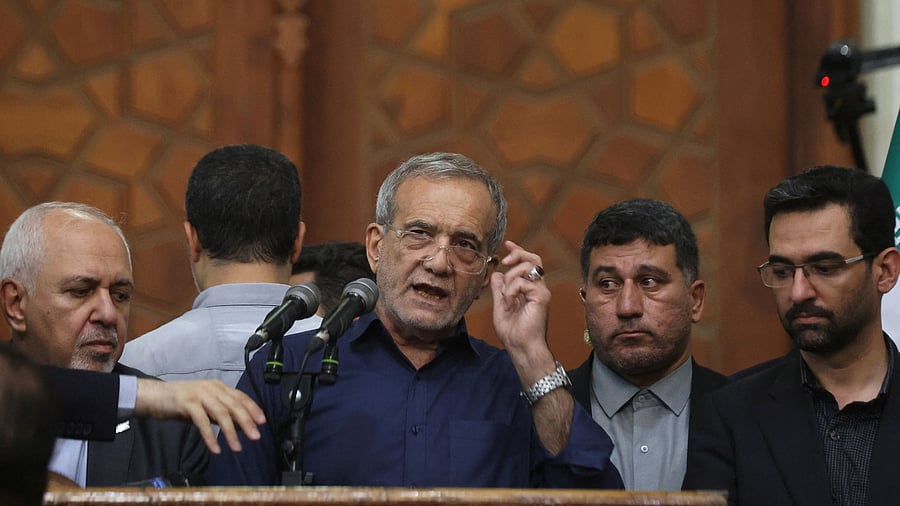
New Iran president Masoud Pezeshkian (Centre).
Credit: Reuters Photo
Masoud Pezeshkian, the new President of Iran, may not be able to bring in the reforms he promised during his election campaign, but undeniably, the victory itself sends a strong message to those who wield real power in Iran. In the Iranian system, the President is supervised by Iran's supreme leader, the unelected Ayatollah, and his handpicked council of Islamic clerics, who ensure that the government does not stray from its chosen path of Shia theocracy. In the five decades that the clergy has run Iran, conservatism has struck deep roots in the political system, judiciary and bureaucracy. But as the protests of nearly two years since the September 2022 death in custody of Mahsa Amini showed, the patience of the Iranian people and civil society is fraying.
The economic misery of years of sanctions is compounded by the restrictions on the citizenry, controlling everything from what they can read to how they should dress. Women are especially affected. The stringent hijab rule, which has been a lightning rod for protests since the time of the 1979 revolution, when it was first introduced in all its strictness, has now become symbolic of all that is wrong with Iran. The election was called after the previous president, the hardline Ebrahim Raisi, who presided over the ruthless suppression of the Amini protests, was killed in an air crash in May. For his campaign, Pezeshkian channelled the still simmering public anger over the 21-year-old's death after she was arrested by the morality police for not wearing her hijab in the prescribed manner, and the voters chose him over his hardline rival Saeed Jalili over two rounds. The first round of polling, held against this background of civil disobedience, saw Iran's lowest turnout of just 40 per cent, indicating an all time low public engagement with politics. This was obvious even when Raisi won in 2021, with a turnout of 48 per cent, a record low at the time. This time, in the first round, Pezeshkian led with 48 per cent of the vote over Jalili, who received 39 per cent of the vote. In the July 5 run off between the two candidates, Pezeshkian pulled away with a lead of more than 9 percentage points, polling 53.6 per cent of the votes against Jalili's 44.3 per cent. The runoff turnout was 50 per cent, showing higher engagement at the possibility of a reformist's win. This too is a message to the Ayatollahs of Iran.
Pezeshkian, a veteran of Iran's politics – he was a parliamentarian before he ran for President, serving as the health minister from 1999 to 2007 – will know that he must walk a tightrope between people's expectations, limited though they are, and the clergy. Economic policy is where he may enjoy the most freedom. Other than the hijab issue, voters also warmed up to him because of his promise to engage with the US and the West to resume stalled nuclear talks and find ways to improve the Iranian economy. Pezeshkian is no America lover. A supporter of the Islamic Revolutionary Guards Corp, Iran's elite strike force that has been designated as “terrorist” by the US, he has said that Iran needs 200 billion dollars in foreign investment. But neither his internal “supervisors”, nor the external geopolitical environment – the war in Gaza, the involvement of Iran's proxies to avenge Israel's aggression, Teheran's own proximity to Moscow and Beijing – will make any of his tasks easier.
